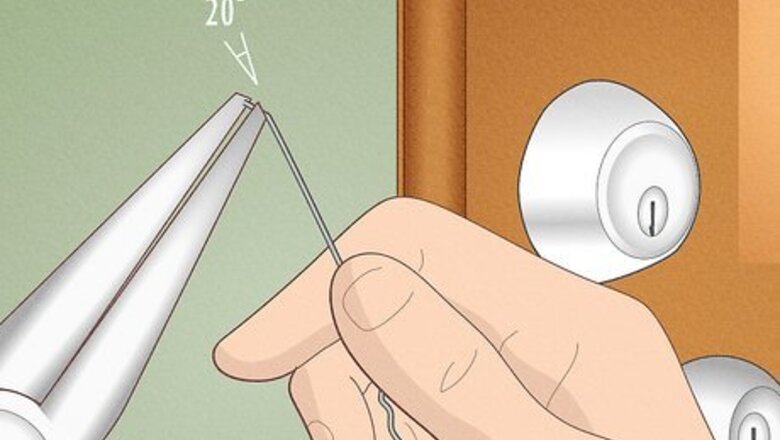
views
- For pin tumbler locks, including deadbolts and entry doors, make a pick set out of 2 bobby pins or paper clips. Stick them into the lock and wiggle them until the lock opens.
- Use an unbent paper clip or a hairpin for locks on privacy door knobs. Poke the item into the door knob's keyhole to release the push button mechanism.
- Unlock a slanted latch-style hook or a spring knob by sliding a credit card into the gap between the door and the jamb. Wiggle it until it presses the latch and opens the door.
Pin Tumbler Lock
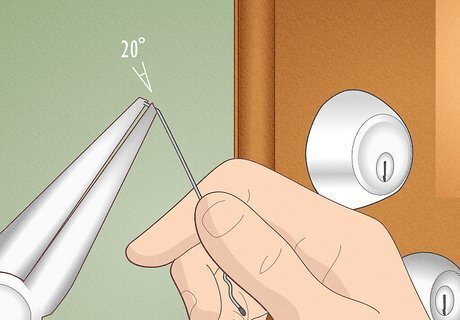
Fashion a lock-pick using a long, thin item. Unbent bobby pins or hair pins work best for picking a pin tumbler lock, but you can also use unbent heavy-duty paper clips or other stiff bits of wire. Create your pick by opening one of the bobby pins or paper clips until it’s bent in half. Then bend the last ⁄8 inch (0.32 cm) of the pick up at a 20-degree angle. If you’re using a hairpin with plastic-dipped ends, scrape the plastic from the end of the pick first using a pair of pliers, the ground, or even your teeth in a pinch. Pin tumbler locks, including deadbolts and entry door knobs, are one of the most secure locks you can get, but with enough patience and care, you can pick them. Pin tumbler locks are constructed of a plug, a row of pins (including driver pins and uneven key pins) that sit in the plug, a housing, and a shear line, which separates the plug from the housing. The driver pins sit atop the key pins inside the lock. The plug (where the key pins sit when the door is locked) is located below the housing (where a key or a pick pushes or “binds” the pins to unlock the door).
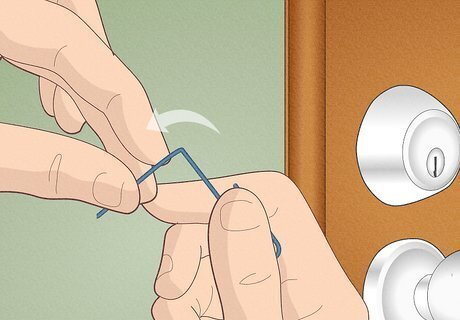
Make a tension wrench by bending a long piece of wire or metal into an L. The tension wrench needs to be fairly sturdy, so use a heavy-duty paper clip or hairpin. Unbend the clip or pin and fold it into an L shape. You can also use a small flat-head screwdriver or similar item that fits into the bottom of the keyhole as a tension wrench.
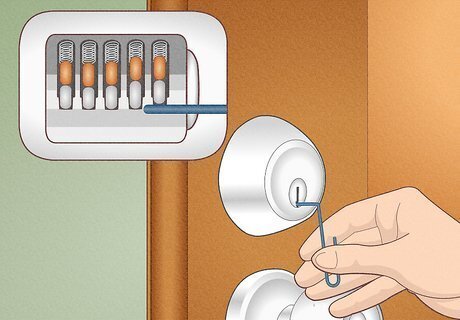
Put the wrench in the keyhole and turn to locate the binding pin. Turn the wrench in the direction you’d turn a key. Apply only soft pressure here: the goal isn’t to lift all the pins at this stage but to locate the binding pin, or the first pin that moves to unlock the door. The binding pin will be the stiffest pin to move. On a perfectly constructed plug, the holes that hold the rows of pins would be precisely aligned with one another, but due to machine error, there are always a couple of holes that are centimeters off the plug’s centerline. This means that when you turn the plug to raise the pins and unlock the door, the pins will bind in a certain order, starting with the pins farthest from the plug’s centerline. The farthest pin—the first to bind—is known as the binding pin.
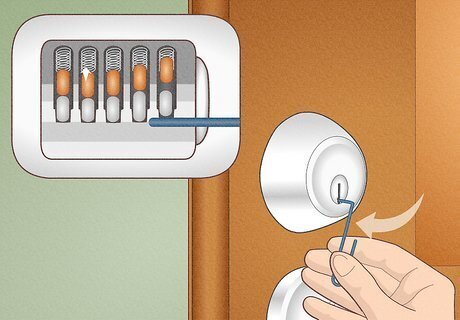
Turn the plug to separate the binding driver pin from its key pin. This is known as “setting a pin.” Once you’ve figured out which of the pins is the binding pin, gently push it up with your tension wrench so that the driver pin is in the housing, and slowly twist to turn the plug. When the plug is turned just slightly, the driver pin will separate from the key pin, and the driver will rest atop the plug. Make sure to maintain the same amount of tension to keep the pins separated: if you move the plug moves back into its starting position, the driver pin will slide out of the housing, below the shear line, and back onto the key pin again.
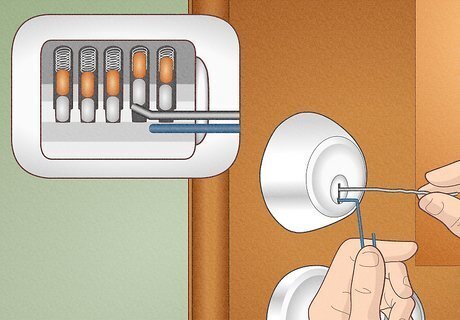
Insert the pick to find the next binding pin. The second binding pin will now be the stiffest pin to move. Keep your tension wrench in place, and maintain the same tension so that your first binding driver pin doesn’t fall out. Use your pick to locate the next binding pin, and then use your wrench to twist the plug to set the pin, separating the driver and key pins again. When using a key, you lift all the key pins, keeping them together with their respective driver pins, but when picking the lock, you separate the key pins from the driver pins. This means that as you locate and set your binding pins, you might hear the separated key pins jiggling around inside the plug. Don’t be alarmed!

Turn the plug to set the second binding pin, and repeat for all pins. Keep wiggling your pick to locate the next binding pins, but make sure not to let your already separated driver pins fall out of the housing.
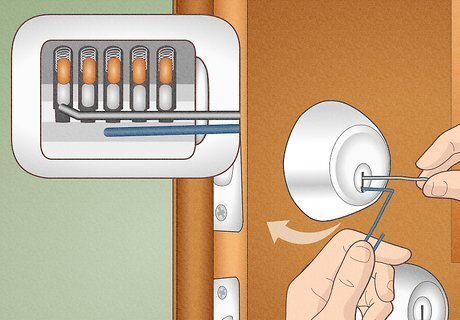
Use the wrench to turn the plug once you’ve set all the pins. If you’ve successfully identified your binding order and set all your pins, nudging the drivers above the shear line, the plug will rotate, and the lock will disengage. Your door is now unlocked! This process can take a lot of time and patience. If you don’t unlock the door immediately, don’t be discouraged!
Privacy Knob Lock
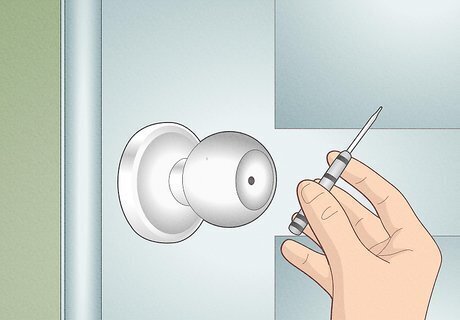
Find a long, thin object for picking the lock. To pick the lock, choose an object that’s small enough to fit into the hole, but sturdy enough to put pressure on the locking mechanism. Ideal choices include a small screwdriver or hex wrench, a hairpin, or a heavy-duty paper clip. Use a bamboo skewer from the kitchen or a cotton swab with the fluff removed from one end if you don’t have paper clips or hairpins. If you’re using a hairpin or paper clip, first bend it open so you have a long, straight bit of metal. If you’re having trouble finding a suitable object, get creative! Open up a ballpoint pen and use the ink cartridge, or check the bottom of your purse for a toothpick. You can almost always find something that will work.

Insert the item into the knob’s hole to pick the lock. The outside door knob will have a small round hole in the center, which is intended to allow for emergency access. If the lock has a push button mechanism, just insert the tool straight into the hole until you feel some resistance, and push. If the lock has a twisting mechanism, insert the tool and sweep it around in a twisting motion until it catches on something, and then apply a bit of pressure. When the door clicks, that means it’s unlocked. When opening a twist-lock, try sweeping the tool both counterclockwise and clockwise until the lock releases. If the outside door knob has a keyhole instead of a hole, it’s not a privacy door knob, but an entry door knob, which uses a pin tumbler lock.

Remove the door knob if you can’t pick the lock. Most privacy door knobs are held together with 2 visible screws. Find a screwdriver that fits, and undo these screws, alternating back and forth between the screws as you go. Within a few minutes, both door knobs will come off. Simply pull any remaining locking mechanism out of the hole and open the door. You may have to apply some tension to the door knob by pulling on it as the screws loosen. The screws may be hidden under a decorative collar. If so, remove the collar by either inserting a paperclip into a small hole on the collar that releases it (if there is a hole) or gently prying up the collar with a flathead screwdriver.
Slanted Latch Hook or Spring-Loaded Knob
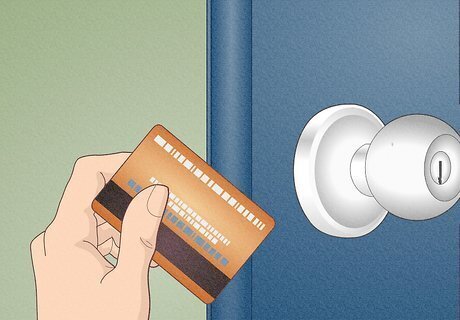
Find a stiff but flexible plastic card. Make sure the card can bend without breaking but is firm enough to pick the lock. A grocery store loyalty card or a laminated library card works great. Even a stiff business card will work on some locks. Note that you can’t use a credit card to unlock a pin tumbler lock. Cards can only be used to unlock slanted latch-style hook locks or spring-loaded knobs. Though many people talk about “picking a lock with a credit card,” avoid using your actual credit or debit card, as it might get damaged in the process!
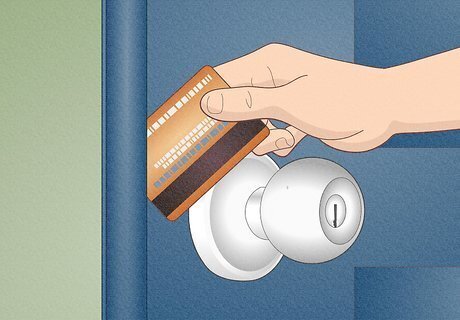
Slide the card in between the door and door jamb. Begin just above the door handle, and slide the card down at a downward angle. Keep sliding it in until you hit the catch. The latch is located parallel to the door handle, in between the door and the jamb.

Wiggle the card to unlock the door. Be gentle, and don’t force it—this could cause the card to break. Wiggling the card will cause it to press against the latch assembly and allow you to open the door. Some doors open almost instantly using this technique, whereas others require more effort. Experiment with different cards, and different angles. Remember that this technique only circumvents the lock; it doesn't actually unlock the door. If you let the door close before you go in, you could end up locked out all over again!


















Comments
0 comment